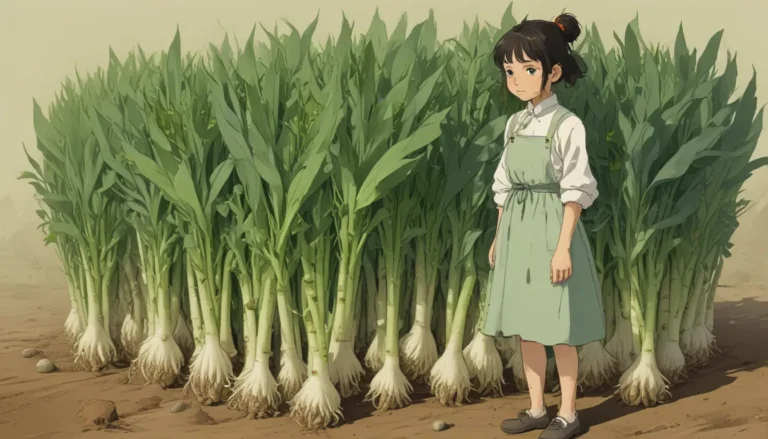The Ultimate Guide to Growing and Enjoying Ornamental Maiden Grass

Are you looking to add a touch of the wild to your garden? Do you want to transform your ordinary landscape into a stunning masterpiece? Look no further than the ornamental superstar known as Miscanthus sinensis, also referred to as Japanese or Chinese silver grass, and lovingly called maiden grass.
This perennial native to Eastern Asia is a garden sensation that can elevate the aesthetic of your outdoor space. With its vibrant colors, unique texture, and striking plumes, maiden grass can take your garden beds to the next level.
In this comprehensive guide, we will delve into the world of maiden grass and explore everything you need to know to grow and enjoy this versatile plant. From cultivation and propagation to growing tips and maintenance, we’ll cover it all. So, get ready for a whimsical adventure as we uncover the secrets of maiden grass together.
Let’s take a closer look at what you can expect to learn in this guide:
What You’ll Learn
- What Is Maiden Grass?
- Cultivation and History
- Propagation
- How to Grow
- Growing Tips
- Pruning and Maintenance
- Cultivars to Select
- Managing Pests and Disease
- Best Uses
- Quick Reference Growing Guide
What Is Maiden Grass?
Maiden grass, or Miscanthus sinensis, is a captivating ornamental perennial known for its graceful, fountain-like appearance. With its distinctive blade-like leaves, colorful foliage, and textured flower plumes, this plant can truly transform your garden into a work of art.
One of the key features that sets M. sinensis apart from other ornamental grasses is its serrated leaves with whitish to silvery midribs and pink to red flowers that bloom in loose terminal panicles. This plant thrives in USDA Hardiness Zones 4 to 9 and offers seasonal interest with its changing foliage colors and striking blooms.
From its origins in Eastern Asia to its journey to North America, maiden grass has a rich history of cultivation and practical uses. Once used for roof thatching, dye production, and soil stabilization, this versatile plant has evolved into a popular landscaping choice for its adaptability and low-maintenance nature.
Cultivation and History
The history and cultivation of maiden grass trace back to its native regions of Japan, Korea, and China. With a long tradition of practical uses ranging from roofing materials to biomass energy production, this plant has played a significant role in the landscape of its native countries.
In North America, maiden grass made its mark in the early 1940s and quickly gained popularity for its aesthetic appeal and versatility. As it spread across the continent, it became a staple in landscape designs, offering texture, color, and movement to various settings.
While maiden grass has found widespread acceptance in many regions, its invasive potential in certain areas has raised concerns. It’s essential for gardeners to be aware of the risks associated with some cultivars and to choose sterile varieties to prevent unintended spread.
Maiden Grass Propagation
Home gardeners can propagate some cultivars of M. sinensis from seed, while others require clonal reproduction. Whether you choose to start from seed or divide mature plants, there are multiple methods available for propagating maiden grass.
From seed starting in late winter to division in the spring, each approach offers a unique way to propagate this versatile plant. By following the recommended guidelines and selecting appropriate cultivars, you can expand your garden with ease.
From Seed
Growing maiden grass from seed is a rewarding process that requires care and attention to detail. By starting seeds indoors in a controlled environment, you can ensure successful germination and healthy seedlings for transplanting.
With the right soil mix, light exposure, and watering regimen, you can nurture maiden grass seeds into vibrant plants ready for the garden. Remember to select cultivars that do not self-seed and have low invasive potential to prevent unintended spread.
Division
Dividing mature maiden grass plants is a practical way to propagate this ornamental grass and rejuvenate established clumps. By carefully separating sections of the plant and replanting them in suitable locations, you can create a sustainable source of new growth.
Before attempting division, make sure to confirm the legal status of your plant variety and follow proper procedures to minimize stress and ensure successful establishment. With the right timing and techniques, dividing maiden grass can be a rewarding experience for any gardener.
Transplanting
Transplanting maiden grass requires careful planning and preparation to ensure optimal growth and establishment. By selecting sunny, well-draining locations and providing adequate spacing, you can create an ideal environment for your plants to thrive.
From container gardening to outdoor planting, there are multiple options available for growing maiden grass in diverse settings. By following best practices for soil preparation, watering, and maintenance, you can enjoy the beauty and benefits of this versatile plant year-round.
How to Grow Maiden Grass
Maiden grass is a cold-hardy perennial that thrives in USDA Hardiness Zones 4 to 9. With its preference for full sun and well-draining soil, this plant is well-suited to a wide range of garden settings.
By providing adequate sunlight, water, and soil conditions, you can encourage healthy growth and vibrant foliage in your maiden grass plants. Whether grown in containers or in the ground, this versatile plant offers year-round interest and seasonal beauty for your landscape.
From soil pH levels to nutrient requirements, maiden grass has specific needs that contribute to its overall health and vitality. By following recommended guidelines for planting, watering, and fertilizing, you can create an optimal environment for your plants to flourish.
Growing Tips
To ensure successful growth and maintenance of maiden grass, consider the following tips:
- Plant in a full sun location with well-draining soil and a pH level of 5.5 to 7.0.
- Water new plantings regularly until established, and during dry spells after that.
- Space plantings 3 to 5 feet apart to accommodate mature size.
- Apply a general, all-purpose fertilizer in early spring if desired.
By following these recommendations and adapting them to your specific growing conditions, you can create a thriving garden filled with vibrant maiden grass plants.
Pruning and Maintenance
Regular pruning and maintenance are essential for the health and longevity of maiden grass plants. By trimming the foliage in late winter or early spring, you can rejuvenate the plant and stimulate fresh growth for the upcoming season.
Maiden grass is relatively low maintenance once established, as it is drought-tolerant and resistant to pests and diseases. Regular monitoring and care can help you identify and address any issues before they become serious.
To maintain the size and structure of your maiden grass plants, consider dividing clumps every two to four years to promote healthy growth and prevent overcrowding. By following proper pruning and maintenance practices, you can ensure a vibrant and flourishing garden year after year.
Maiden Grass Cultivars to Select
With a wide range of M. sinensis cultivars available, choosing the right one for your garden can be an exciting and rewarding process. Here are some popular cultivars to consider:
- Gracillimus: A classic choice known for its narrow leaves and graceful form.
- Morning Light: Notable for its variegated foliage and light contrast.
- Silver Feather: Especially hardy and resilient to cold temperatures.
- Zebrinus: Stands out with its horizontal zebra stripes and tolerance to diverse soil conditions.
By selecting cultivars that suit your climate, soil, and aesthetic preferences, you can create a diverse and visually appealing garden filled with vibrant maiden grass plants.
Managing Pests and Disease
While maiden grass is generally resistant to pests and diseases, there are some common issues to be aware of:
Pests
- Aphids: Sap-sucking bugs that can cause distortion and yellowing of leaves.
- Mealybugs: Soft-bodied insects covered in a white, waxy substance that can stunt growth.
- Spider Mites: Arachnids that feed on plant cells, causing yellowing and browning of leaves.
By monitoring your plants regularly and implementing appropriate control measures, you can protect your maiden grass from pest infestations and ensure healthy growth.
Diseases
- Leaf Rust: A fungal disease that causes yellow, orange, or red blisters on leaves.
- Miscanthus Blight: Attacks leaf blades and sheaths, leading to severe infection and death.
By practicing good garden sanitation, removing infected leaves, and applying fungicides as needed, you can prevent and manage common diseases affecting maiden grass plants.
Best Uses of Maiden Grass
Maiden grass is a versatile ornamental plant that can be used in various ways to enhance your landscape:
- Privacy Screens: Create a natural barrier with tall, vibrant maiden grass plants.
- Specimen Plants: Showcase the unique beauty and seasonal interest of maiden grass in a focal point.
- Mass Planting: Design large garden beds or meadows filled with the movement and color of maiden grass.
- Container Gardening: Grow maiden grass in pots to add height and texture to your patio or garden.
With its adaptability and aesthetic appeal, maiden grass offers endless possibilities for creative and practical landscaping solutions.
Take a Walk on the Wild Side
In conclusion, growing and enjoying maiden grass in your garden can be a rewarding and enriching experience. By following the guidelines and tips outlined in this guide, you can create a vibrant and thriving landscape filled with the beauty and charm of ornamental grasses.
If you’re ready to embark on a whimsical adventure with maiden grass, start by selecting the right cultivars, preparing your soil, and providing the necessary care and maintenance for your plants. With a little creativity and dedication, you can transform your garden into a stunning masterpiece that rivals the beauty of nature itself.
We hope this guide has inspired you to explore the wild and wonderful world of maiden grass and incorporate this versatile plant into your outdoor space. Share your ideas and photos with us in the comments below, and let’s continue the conversation about cultivating ornamental grasses in the garden.
For more information on growing and caring for ornamental grasses, be sure to check out our related guides and resources for additional tips and inspiration:
- Easy Landscaping with Ornamental Grasses: Simple Tips for Carefree Success
- How to Grow and Care for Fountain Grass
- How to Grow and Care for Mondo Grass
Let’s continue the journey of discovery and transformation with maiden grass as our guide. The possibilities are endless, and the rewards are boundless. Happy gardening!
I hope this revamped article provides valuable insights and information to help readers grow and enjoy ornamental maiden grass to the fullest. Let me know if you need further improvements.





